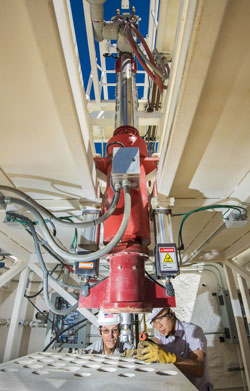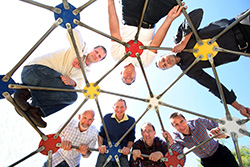Sandia Labs worked on new type of downhole hammer ALBUQUERQUE, N.M. — Sandia National Laboratories and a commercial firm have designed a drilling tool that will withstand the heat of geothermal drilling. The downhole hammer attaches to the end of a column of drill pipe and cuts through rock with a rapid hammering action similar […]
Category Archives: Materials Science
Older posts | Newer posts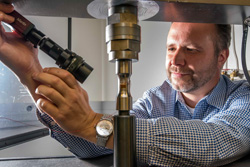
Lessons from cow eyes: The long-term impacts of studying cornea biomechanics
ALBUQUERQUE, N.M. – Nature has had millennia to optimize biomaterials for useful properties, from lightweight strength to walking on smooth, vertical surfaces. Mother-of-pearl, spider silk, cholla wood “skeletons” and gecko feet are all good examples of nature’s brilliant materials engineering. The study of gecko feet spurred research into dry nano-adhesives, and research into lightweight yet […]
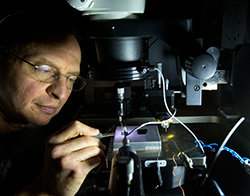
Ingenious method enables sharper flat-panel displays at lower energy costs
ALBUQUERQUE, N.M. — A perpetual quest of manufacturers and viewers is for ever-brighter colors and better images for flat-panel displays built from less expensive materials that also use less electricity. An intriguing method discovered by Sandia National Laboratories researcher Alec Talin and collaborators at the Center for Nanoscale Science and Technology at the National Institute […]
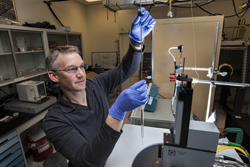
Smaller. Cheaper. Better.
Iron nitride transformers developed at Sandia could boost energy storage options ALBUQUERQUE, N.M. — A Sandia-led team has developed a way to make a magnetic material that could lead to lighter and smaller, cheaper and better-performing high-frequency transformers, needed for more flexible energy storage systems and widespread adoption of renewable energy. The work is part […]
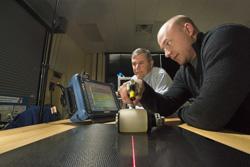
Nondestructive testing: Sandia looks inside composites
ALBUQUERQUE, N.M. — Researcher David Moore holds a rectangle of hard carbon composite material, smooth with a faint woven pattern on its surface. The sample shows normal wear and tear until he turns it over to reveal a circular impact mark with cracks radiating from it. The question for Moore, his Sandia National Laboratories colleague […]
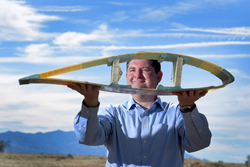
Enormous blades could lead to more offshore energy in U.S.
ALBUQUERQUE, N.M. — A new design for gigantic blades longer than two football fields could help bring offshore 50-megawatt (MW) wind turbines to the United States and the world. Sandia National Laboratories’ research on the extreme-scale Segmented Ultralight Morphing Rotor (SUMR) is funded by the Department of Energy’s (DOE) Advanced Research Projects Agency-Energy program. The […]
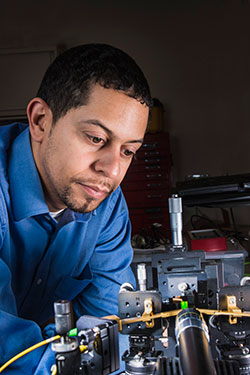
Unique phononic filter could revolutionize signal processing systems
ALBUQUERQUE, N.M. — A unique filtering technology that combines light and sound waves on a single chip is expected to better detect radar and communications frequencies. “We have developed a powerful signal filtering technology that could revolutionize signal processing systems that rely solely on conventional electronics,” said Patrick Chu, manager of applied photonic microsystems for […]

Thor’s hammer to crush materials at 1 million atmospheres
Sophisticated features may influence eventual Z-machine rebuild ALBUQUERQUE, N.M. — A new Sandia National Laboratories accelerator called Thor is expected to be 40 times more efficient than Sandia’s Z machine, the world’s largest and most powerful pulsed-power accelerator, in generating pressures to study materials under extreme conditions. “Thor’s magnetic field will reach about one million […]
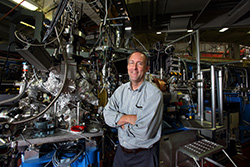
Bay Area national labs team to tackle long-standing automotive hydrogen storage challenge
LIVERMORE, Calif. —Sandia National Laboratories will lead a new tri-lab consortium to address unsolved scientific challenges in the development of viable solid-state materials for storage of hydrogen onboard vehicles. Better onboard hydrogen storage could lead to more reliable and economic hydrogen fuel cell vehicles. “Storing hydrogen on board vehicles is a critical enabling technology for […]
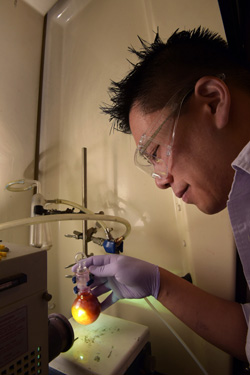
Way cheaper catalyst may lower fuel costs for hydrogen-powered cars
‘Green’ process runs on sunlight ALBUQUERQUE, N.M. —Sandia National Laboratories researchers seeking to make hydrogen a less expensive fuel for cars have upgraded a catalyst nearly as cheap as dirt — molybdenum disulfide, “molly” for short — to stand in for platinum, a rare element with the moonlike price of about $900 an ounce. Sandia-induced […]
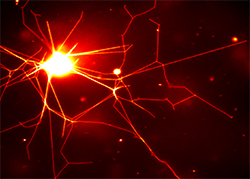
Biological tools create nerve-like polymer network
Crowdsurfing motor proteins create possible prosthetic interface ALBUQUERQUE, N.M. — Using a succession of biological mechanisms, Sandia National Laboratories researchers have created linkages of polymer nanotubes that resemble the structure of a nerve, with many out-thrust filaments poised to gather or send electrical impulses. “This is the first demonstration of naturally occurring proteins assembling chemically […]
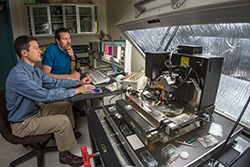
Phonons, arise!
Small electric voltage alters conductivity in key materials ALBUQUERQUE, N.M — Modern research has found no simple, inexpensive way to alter a material’s thermal conductivity at room temperature. That lack of control has made it hard to create new classes of devices that use phonons — the agents of thermal conductivity — rather than electrons […]

Iron rain fell on early Earth, new Z machine data supports
ALBUQUERQUE, N.M. — Researchers at Sandia National Laboratories’ Z machine have helped untangle a long-standing mystery of astrophysics: why iron is found spattered throughout Earth’s mantle, the roughly 2,000-mile thick region between Earth’s core and its crust. At first blush, it seemed more reasonable that iron arriving from collisions between Earth and planetesimals — ranging […]
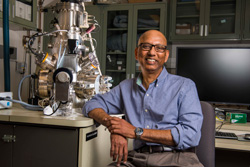
Asian American engineering honorees credit families for success
ALBUQUERQUE, N.M. — Two scientists at Sandia National Laboratories thought back to their roots when they won Asian American Engineer of the Year (AAEOY) awards: Somuri Prasad to a village in India and Patrick Feng to a refuge in America. Prasad’s father helped found the first school in his native Pasumarru in the Krishna District […]
